- Tools for work
- Main stages
- Tips for choosing material
A new piece of furniture in the house always brings a certain joy to the owners. It's hard to imagine an apartment without a sofa, armchairs and other upholstered furniture. But after a few years, the upholstery loses its former attractiveness, becomes unusable and no longer fits into the interior of the room. Often in such cases it is thrown into a landfill or taken to the country. Sometimes they invite specialists who reupholster and give the furniture new look.
But not everyone knows that reupholstering a sofa with your own hands is not a very difficult task.
How to repair furniture at home, what difficulties can you encounter and how to overcome them? Difficulties may arise if:
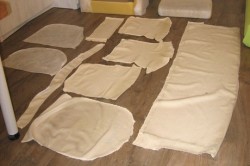
The cutting of fabric furniture parts is done according to patterns.
- The furniture has a very complex design and it is difficult to make out.
- Individual parts are made in complex geometric shapes, making it difficult to correctly cut new upholstery.
- The service life of furniture is 7-10 years; not only reupholstery is required, but also frame repairs and replacement of the filling. Professionals can do this job better.
- The furniture is expensive, antique, you don’t want to accidentally ruin it.
- It is planned to use natural leather as a new material for the upcoming reupholstery, which is not easy to work with.
In all other cases, you can reupholster any sofa yourself. It is worth considering this issue step by step.
Tools for work

Sofa upholstery: a – soft and upholstery materials; b – cutting; c – order of upholstery and reupholstery.
When performing work on reupholstering home upholstered furniture, the following tools may be required:
- A flathead screwdriver or staple remover to remove old staples.
- Wrenches from 8 to 19 mm.
- Nippers, side cutters and scissors.
- Stapler.
- Sewing machine.
- Titan threads with high strength.
- Decorative buttons may be needed to decorate pillows.
Return to contents
Main stages
Do-it-yourself reupholstery of a sofa and other upholstered furniture includes several main steps:
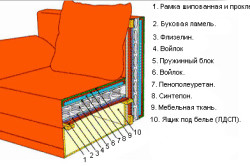
- Disassembly with removal of individual components in the form of pillows, sides, poufs. A diagram of a spring sofa is presented. Disassembling the sofa is done using some tools. First, carefully disconnect the sides, remove all the overhead elements, the seat and the back. This is usually done quite simply, since manufacturers assemble furniture with high maintainability. Place all fasteners in a container so as not to lose them.
- Removing old upholstery that has become unusable. Worn upholstery can be removed using an anti-staple gun, which can be replaced with a regular flat-head screwdriver. The work requires a certain amount of care so as not to tear the old covering and use it as a template for cutting out parts from new fabric. All internal cavities are cleared of debris and dust. Old foam rubber should be mercilessly thrown away, since usually only dust remains from it. All metal mesh, various kinds of stretch marks, as well as springs need to be carefully inspected and some detected defects must be eliminated. Nylon or fabric stretchers should be replaced with new ones. All screws must be carefully tightened, the joints of the parts must be strengthened, and the wooden joints must be glued.
- Uncover new upholstery parts. The result of the entire reupholstery of the product largely depends on the quality of the new patterns. Old upholstery can serve as a pattern for the pattern, if you leave an allowance of a few centimeters at the edges of the new fabric. Worn parts of old upholstery are placed on new fabric and traced with chalk, then cut out with tailor's scissors.
- Attaching new upholstery to furniture parts. The fabric on the sofa parts is stretched evenly so that the pattern on the fabric does not warp. The material is secured using a stapler. The distance between the staples should not exceed 4 cm. In order not to make a mistake with the amount of new fabric, it is recommended to buy it with a small margin. The remaining material can be covered with kitchen stools or sewn from it decorative pillows. Foam rubber is cut out and attached in the same way as fabric. You can cut it sharp knife. Leftovers can also be used to upholster stools and sew decorative pillows.
- Assembly of an updated design.
In the same order, any constriction is performed, including corner sofa.
Reupholstering a sofa and covering upholstered furniture at home is possible even without the involvement of a specialist. This procedure is not as complicated as it looks at first glance. There are many step-by-step master classes on the Internet with photos and videos, which tell in detail how to upholster upholstered furniture with your own hands, and what material to use for this purpose. After looking at them, you can update any furniture set and make the interior of your home unique.
What is sofa reupholstery?
Over time, any soft set loses its original appearance: the covering tears, gets dirty, fades, and defects appear on it. But this is not a reason to run to the store - it is much cheaper to update a chair or reupholster a sofa at home. To do this, you need to decide on the choice of upholstery material, stock up on all necessary tools. Reupholstering sofas consists of 5 main stages:
- disassembly into component parts;
- removing old upholstery;
- cutting out new matter;
- upholstery of every detail;
- strengthening, assembling the structure.
Sofa upholstery material
The choice of material for upholstering a sofa must be approached responsibly. Give preference to hard fabrics: leather, jacquard, tapestry, flock. Due to their density, they are resistant to wear, which extends the life of the headset. Before the purchase upholstery material, decide on the purpose of the furniture. If you'll only be sitting on the sofa, choose a fabric that contains synthetic fibers, which will last longer. Do you plan to use it as sleeping place? Then opt for natural materials.
Upholstery of a sofa with leather
Replacing the upholstery of a leather sofa is the most difficult, time-consuming and expensive process. The leather for upholstering a sofa must be of high quality, not cheap, otherwise it will not last long. The rear parts can be upholstered with leatherette, similar in color and texture to leather - this way the restoration will be cheaper. It is important to renew not only the damaged part, but to reupholster the ottoman completely, otherwise old material will contrast with the new one. When cutting leather, keep in mind that it may shrink over time, so leave another 1 cm for allowances.
Fabric for sofa upholstery
In several stages, the sofa is reupholstered with fabric and one of important points is the choice of upholstery material. Such a piece of furniture is a favorite place for the whole family, so the upholstery should be practical, not brand-new. The following types of fabrics meet these criteria: leather, its high-quality substitute, chenille, tapestry, jacquard, synthetic vinyl. The color is selected individually at will and in accordance with the overall design style of the room.
When choosing upholstery, pay attention to natural species materials without a specific odor, which may indicate the presence of toxic dyes. You should not buy cotton fabrics; they wrinkle a lot, quickly fade, and wear out. If there is a pattern, it is better to give preference to a small print, which will make it easier to re-upholster the covers and reduce the consumption of material when upholstering. When choosing a fleecy fabric, pay attention to the uniform distribution of the pile - this is a sign of the quality of the material.
How to reupholster a sofa
Reupholstering a sofa with your own hands will require a lot of time and patience, but it will cost less than the services of a specialist. Having decided on the material, you need to disassemble the restoration object using a screwdriver, screwdriver and nail puller. Disconnect the parts on the sides, overhead elements (back, seats), unscrew all the screws, remove the nails. The next stage is removing the old coating. This must be done very carefully, without damaging it; each detail will serve as a pattern for new patterns.
If necessary, replace springs, belts, foam rubber and other damaged parts, cut new fabric according to old patterns. Further new material stretch evenly over the parts of the restoration object and secure it using a construction stapler. The final stage is the careful and consistent assembly of the updated structure using high-quality fasteners. Use the instructions if you are not sure that you can do everything correctly, without errors.
Upholstery of a corner sofa
The process of reupholstering any furniture consists of the same sequential steps: disassembly, removal of old covering, cutting of new upholstery parts, upholstery with new material individual elements, assembling the updated product. Reupholstering a corner sofa with your own hands follows the same sequence, only its design is a little more complicated, you will have to update two backs and two seats, the work will require more time and effort. 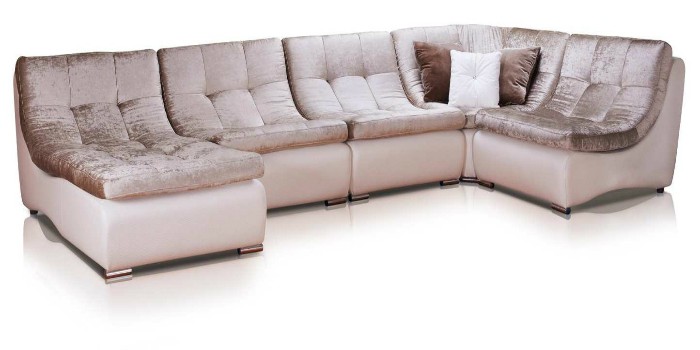
Reupholstering a kitchen sofa
Interior modern kitchen It’s hard to imagine without a kitchen corner. Like any furniture, it becomes unusable over time, and in the kitchen the upholstery can not only be torn. Food gets on it, stains form, temperature changes affect it, so reupholstering kitchen sofa- very important question. The process is no different from updating another set, but the choice of upholstery material needs to be approached more responsibly.
The corner covering must be cleaned and washed well, otherwise the restoration of the sofa will occur frequently. The most suitable materials are: artificial leather, tapestry and flock. Majority kitchen corners covered with eco-leather, high-quality leatherette, which wash well and last for many years. The tapestry was created specifically for updating upholstered furniture, it is durable and easy to clean. Flock is no less durable and wear-resistant; it has a special moisture-repellent impregnation, which is very important for kitchen area.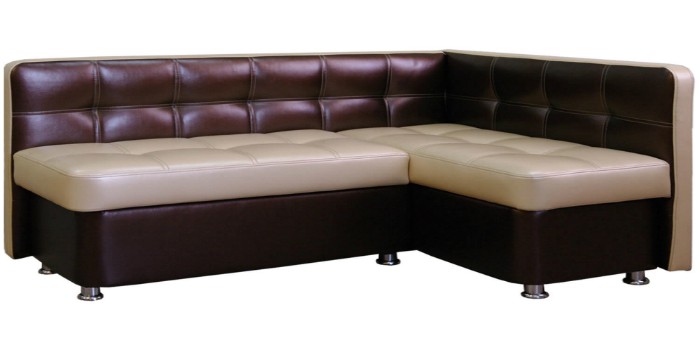
Upholstery of a book sofa
If you decide to restore furniture for the first time, then reupholstering a book sofa is best suited for this. Its design is the simplest of all. existing models, you only need to disconnect the side parts, the back, and the seat. Next, being careful not to damage it, carefully remove old upholstery and internal filling. Repair the damaged parts of the mechanism and replace the foam rubber, cut out new patterns from the old coating using an allowance of 1 cm. Pull them evenly over the parts of the object of restoration, secure with a stapler, and assemble the furniture to be restored. 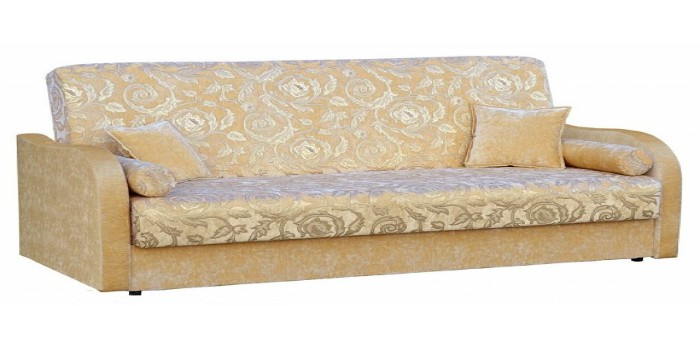
Reupholstering a spring sofa
In addition to the main stages, reupholstering a spring sofa with your own hands includes repairing or replacing the spring frame. After making sure that it is in good condition or replacing the springs, attach the frame to the base with a stapler, and then with stiff wire staples. The use of such fastening will make the structure stronger and more reliable. A layer of felt or polyurethane foam is placed on top of the spring block, then foam rubber, padding polyester, and only then new upholstery. Do the same with the back, assemble the furniture.
Reupholstering sofa armrests
The cost of reupholstering a sofa at home will be lower than in a special workshop. True, not all details can be updated with your own hands; for example, it can be difficult to reupholster the armrests of a sofa. Changing the upholstery on flat, rectangular armrests is not difficult, but such a piece of furniture can be curved, and it is not easy to re-upholster the covers or stretch the fabric evenly. In this case, it is better to entrust the work to specialists.
Over the past ten years, it has become popular to restore old upholstered furniture - Soviet book sofas, seats of dining chairs, favorite armchairs. Reasons that make people give new life old things, practically sentimental - a relic sofa brought by a great-grandfather as a trophy from the war, or an armchair in which the grandmother knitted a lot of socks for a family of three generations.
But more often we are surprised to realize that good quality soviet furniture in terms of the quality and integrity of the frame, it is much better than a new one, located in the low and medium price ranges. Such furniture is often made from raw timber, cheap spring blocks, and covered with cheap and low-quality fabric on top.
A great number of master restorers have appeared - there are even craftsmen who can so transform appearance old sofa, that it will not differ from its modern counterparts in design and content. But, in fact, with minimal business skills, desire and patience, reupholstering upholstered furniture with your own hands is an easy and even creative task.
Do-it-yourself methods for restoring and upholstering furniture
![]()
Furniture restoration allows you to completely transform old interior items
There are two ways to update the appearance of upholstered furniture: washing and replacement. Both options are quite labor-intensive and technically cumbersome, but doable! All your efforts will pay off when you see and feel the fruits of your labor with a feeling of complete satisfaction.
This option is best suited for small pieces of furniture: chair seats, stools and small armchairs. If you like the upholstery fabric on your favorite old sofa and it is well preserved, has a unique woven pattern, and you understand that a modern analogue is unaffordable, then the sofa cover can be put in the wash.

To wash large furniture covers, it is better to use the services of a professional laundry.
- Saving money - you only spend time with small expenses, including the cost of detergents and furniture fittings (staples, lining fabric).
- Reviving the authentic look of a piece of furniture.
There is one minus, but a significant one - there is a high probability that the cover will “shrink” during washing or even fall apart. Since upholstery fabric is not designed for washing, it is not treated for shrinkage, like clothing fabrics, for example.
Complete replacement of furniture cover
This path is the longest and most difficult, but true. Old and shabby upholstery is mercilessly thrown away, and the sofa can please you with brand new fabric in fresh colors. Complete replacement It is quite possible to make a furniture cover yourself at home. But be prepared for problems hidden under a leaky cover: cracked frame beams, broken springs, broken fiberboard or a faulty locking mechanism.
If, upon opening the cover, you are saddened to discover internal damage, do not despair - simply the operation of replacing the cover develops into a more complex, major phase of reupholstering upholstered furniture.
Padding
This relatively new concept includes not only replacing upholstery, but also: complete renovation frame, replacement of foam rubber, locks, spring blocks, everything that is needed. Essentially, constriction is major renovation upholstered furniture, as a result of which you will receive a new interior element made to your taste.

Major repairs allow you to save even the most “dead” furniture
Required tools and materials
In order for the work of reupholstering upholstered furniture to proceed comfortably, smoothly and without unnecessary nerves, you need to prepare the necessary tools in advance.
Tools d For disassembly and assembly work
- A large flat-head screwdriver and pliers are used to pick up and pull out old staples.
- A Phillips or flat-head screwdriver that matches the size of the slot in the heads of the screws securing the lock to the frame.
- Set of wrenches for nuts and bolts.
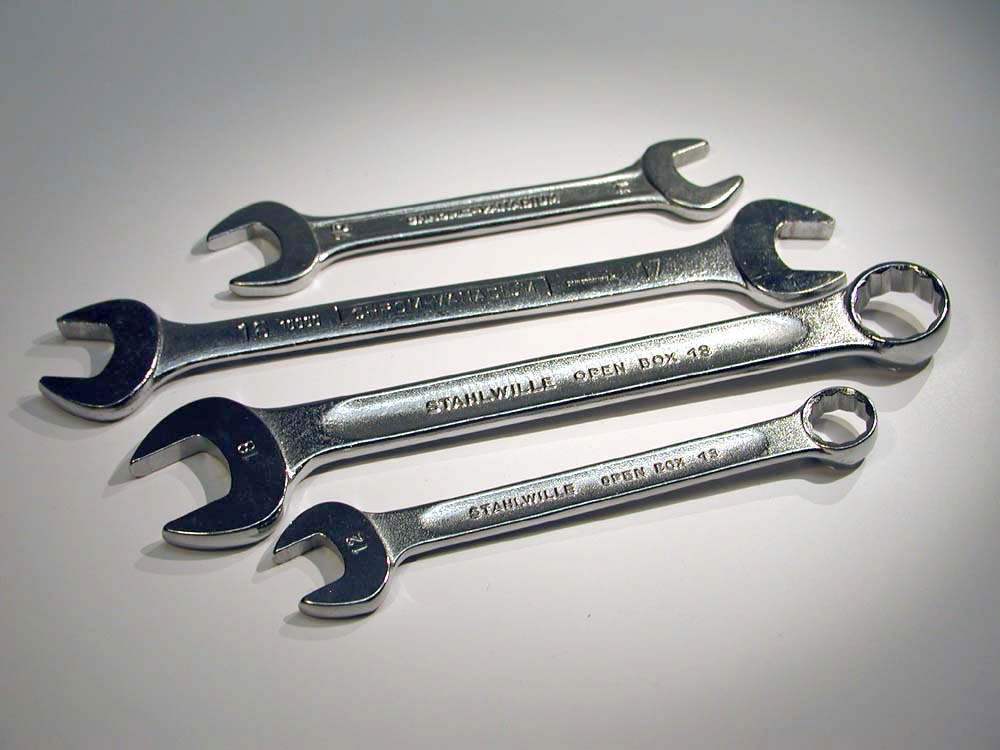
Almost all upholstered furniture frames are bolted, so you can’t do without a set of keys
- Tape measure - take the necessary measurements when replacing body parts.
- Stapler - construction or pneumatic. The second is preferable because, without effort on your part, it drives long, strong staples deep into the wood of the frame, even through several layers of fabric.
- Staples - from 6 mm to 10 mm depending on the thickness and density of the selected upholstery fabric.
- Garbage bags (larger and denser).
To sew new covers you will need:
- New upholstery fabric - the choice in stores is mind-boggling, choose according to taste and cost. In order not to make a mistake with the footage, sketch out approximate details before purchasing. Consider standard width roll - up to 145 cm (together with the edging of the edges of the canvas) and the location of the patterns relative to the pile and shine of the material.
- Lining fabric for padding the back surfaces of the back and seat. This is not necessary, but a layer of lining will protect the furniture from dust getting inside, and the cost of lining material is low. Therefore, it is better not to neglect this simple operation.
- Sharp scissors, preferably special tailor's scissors for cutting.

When cutting new covers, tailor's scissors will be simply irreplaceable.
- Crayons or thin pieces of soap.
- Threads - no less than No. 10, and better - special reinforced ones for rigid fabrics.
- Meter ruler.
- Paper for patterns if you are going to modify the appearance of the product: change the shape of the legs, back and seats.
- Sewing machine.
Constriction technology
Dismantling old furniture
This is the first and dirtiest stage - you have to unscrew and remove the bolts, locks and disassemble the frame. Then remove all the old staples that fasten the upholstery to the frame.
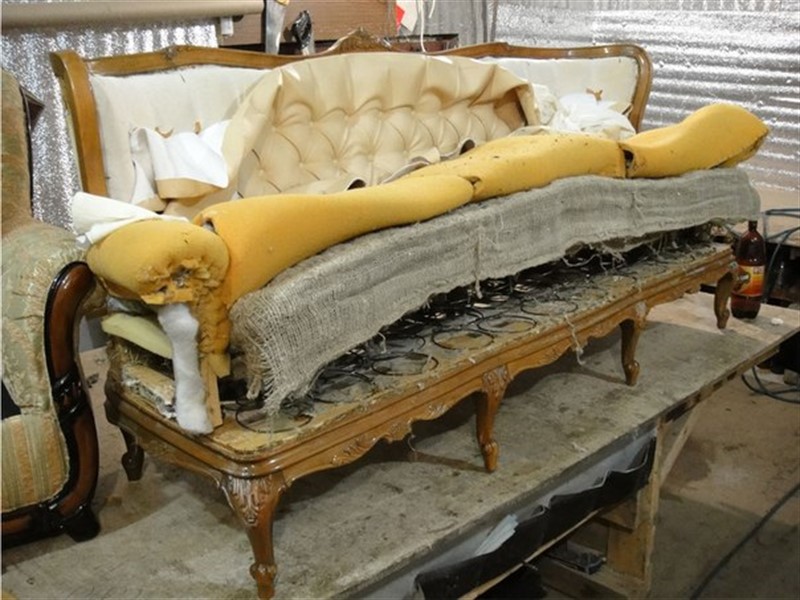
After removing the upholstery, a rather unsightly picture may be revealed to the eye.
Take care of the disassembly site - you will have to stir up the “dust of centuries” that has soaked the sofa or armchair. And staples have a sneaky habit of scattering across the floor and digging into the soles of sneakers (or feet). If it is not possible to disassemble the sofa outside, cover the equipment (TVs, computers, etc.) with film, and take everything that is possible into another room.
Keep garbage bags on hand - you will have to throw away a lot of rubbish that the inside of the sofa (chairs, chairs, etc.) has become. Once you've finished disassembling, immediately remove all resulting debris from your home. Various nasties can lurk in the interior dust of upholstered furniture - from allergens to dust mites.
Repair work and replacement of parts
Having removed the old cover, you may find a number of serious damages under the harmless abrasions of the upholstery; do not rush to give up and throw away the sofa, calculating in your head how much it will cost to buy a new one.
All repair problems can be solved, and parts are replaceable - the list of breakdowns and ways to fix them is not as extensive and scary as you might think at first glance.
Cracked frame beams
All old sofas and armchairs are based on frames held together with locking saws and glue. This is a strong and durable system, much better than modern installation with self-tapping screws. But when the service life ends, the corners of the frames become weak and crack. The beams need to be replaced. Choose a dry tree, without knots, cracks and bark - bast or middle with a smooth, straight structure. Otherwise, the beam, which carries a large load and lacks strength and integrity, will quickly burst. Damp wood in warm and dry apartment conditions will belatedly begin to dry out and warp. It is better to repeat the lock cut - order it from a master carpenter or do it yourself. It is better to soak the joints of the frame beams with PVA glue before joining.
Broken fiberboard parts (lintels of the seat frame and backrest)
Everything is simpler here - you measure the size and cut out new parts yourself with a jigsaw or make them to order in a furniture workshop. It is better to prepare separate parts of the jumpers (in old sofas there are usually three of them - the middle and two sides), which are easier to replace in case of a break. They can be attached to the frame with nails or a pneumatic stapler.
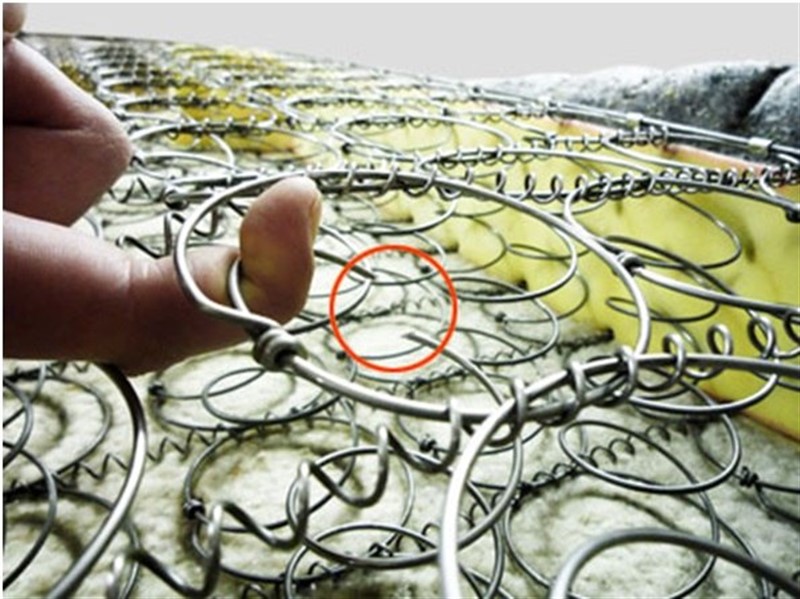
Broken springs not only impair the cushioning properties of furniture, but can also cause injuries and cuts.
The sore spot is the middle of the seat, where children love to jump and guests love to sit. Some craftsmen manage to “twist” spring blocks, replacing broken springs with new ones. However, there is no guarantee that after some time another one will not burst. old spring and for her sake you won’t have to start all the work all over again. Therefore, it is more rational to replace the spring blocks completely.
Replacing seat belts
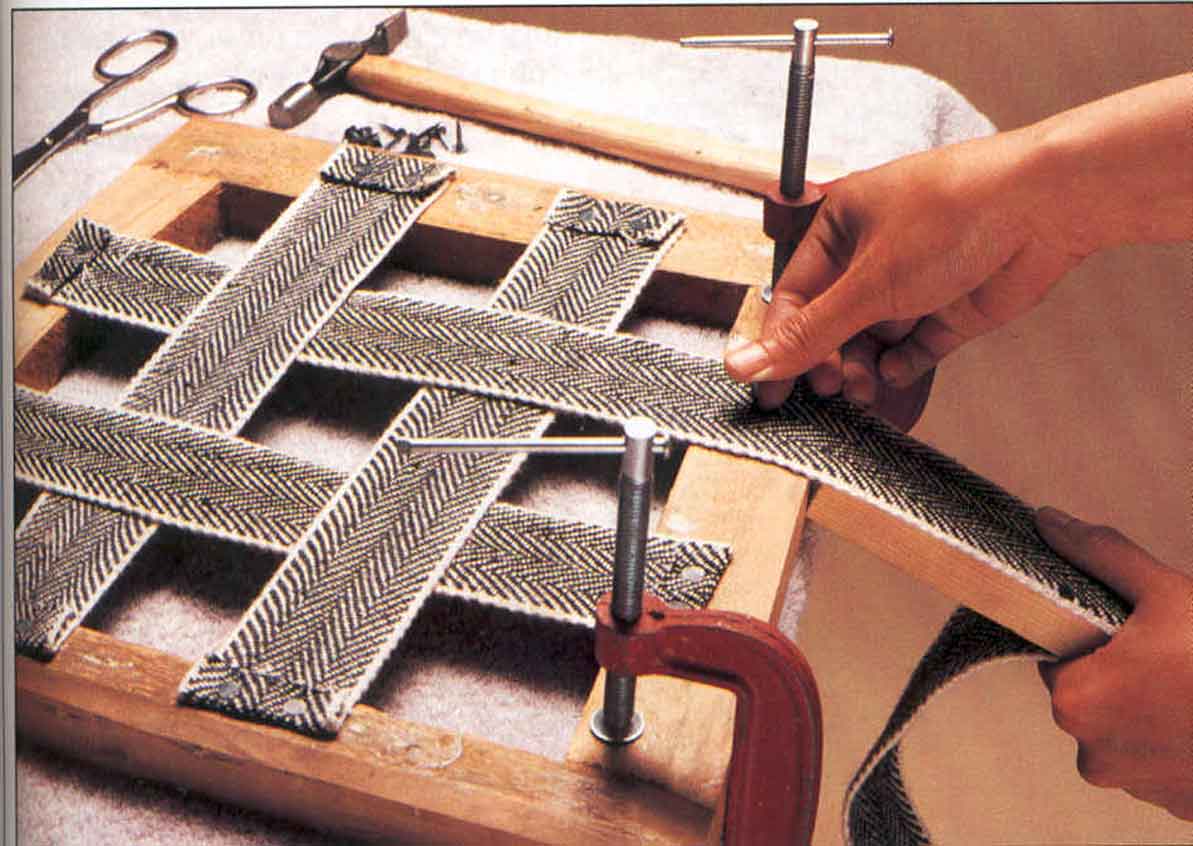
Any dense tape of suitable width can act as belts.
Typically, the frames of the seats and backs of old chairs are tightened with intertwined wide belts, on which foam rubber is laid. And the belts very rarely break; most often the place where the belt and the frame meet is worn out. Any belts that you consider durable will be suitable for replacement. The main thing is that they are tightly woven, preferably from synthetic materials and a width of at least 5–7 cm.
Caked foam rubber
Any type of foam rubber has this technical characteristics, as the number of compressions. This is an indicator of how many times the material will withstand compression and be able to restore its original shape and elasticity. Almost always in old furniture, foam rubber has long outlived its usefulness in this respect and has turned into dust or into a viscous substance reminiscent of sticky plasticine. Throw it away without regret and lay down new foam rubber.

It’s better not to skimp on foam rubber - it’s not only a soft layer, but also protects the internal structure from damage
Replacing locks
Another common problem is that over time, the steel lock mechanism becomes loose, there is play in it, or the springs that lock the lock into the “sitting” or “lying” position fall off. Inspect the lock carefully; you may need to change the screw or install a new latch spring. If not, then the lock will have to be changed - fortunately, this is not a problem, furniture fittings stores will offer you big choice modern castles.
Master class on sewing new covers
The most creative stage of work. You can leave the look of the furniture the same; in this case, you can use old covers as patterns. Before work, they should be thoroughly shaken and vacuumed.
When cutting new parts, carefully monitor the location of the weft and warp threads, as well as the direction of the pile. This is especially true for the patterns of the backrest and seat-back, if the width of the fabric does not allow making a one-piece cover (meaning the upholstery of a sofa-book).
With creativity and sewing skills, you can transform the look of old furniture to make it more modern, comfortable and suit your taste. The main part of the modifications is achieved with foam rubber overlays - soft bolsters are added on the side panels, and backrest headrest pads are added. You can take into account the position of the body in a sitting position and add foam pads on the seat (under the knees) and inserts under the lower back.
When using darts, folds, and curly details, the covers will be completely new uniform and become more modern.
In order to do a high-quality and beautiful job of modifying the appearance of upholstered furniture, you need basic cutting and sewing skills. If you are not confident in your abilities, it is better not to risk doing it yourself, but hire a specialist to do the work.
Nuances of cutting and sewing
- Leave seam allowances of 1 – 1.5 cm depending on the density of the fabric.
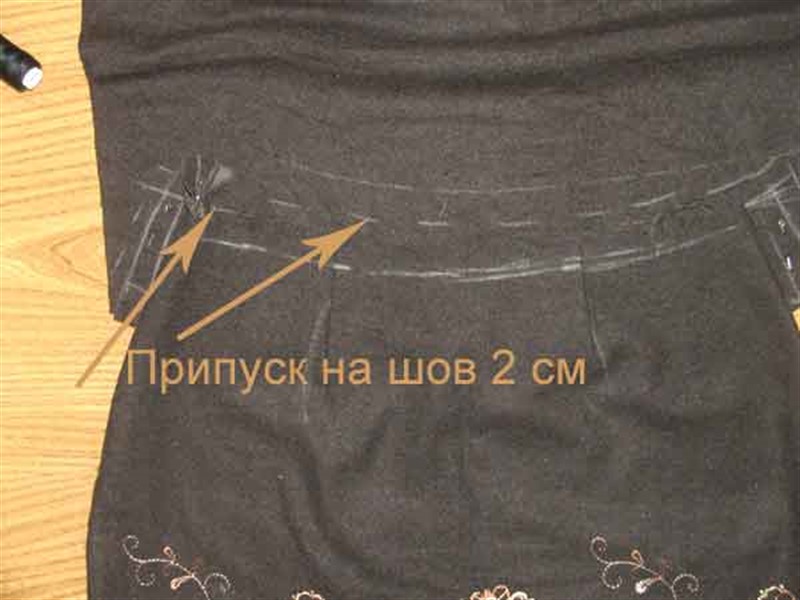
When cutting fabric, be sure to leave 1-1.5 centimeters for seams
- It is advisable to process the edges of the sewn parts with an overlock or zigzag stitch.
- Upholstery fabric with a large pile must be basted by hand before machine stitching to avoid moving parts.
- If leatherette, artificial or natural leather is chosen for the upholstery, then when making facial finishing seams, use it as a presser foot sewing machine use a special roller. As a last resort, you can coat the surface of the fabric under the presser foot. thin layer machine oil.
- In case of sewing into a cover decorative overlays, baste the folds by hand.
As often as possible during the sewing process, do fittings - foam rubber, a softening hard spring frame, a pliable material, the shape of which is determined by the cover.
Attaching new covers to upholstered furniture parts
The repair work has been completed, the covers have been sewn, it’s time to begin the important stage of stretching the new upholstery. You need to clearly understand that the final result and appearance of your chair or sofa depend on the quality of this stage. You will need patience and accuracy in your work.
At the stage of the last fitting, it will still be possible to correct mistakes - sew in or loosen the corners a little, alter the darts. Do not be alarmed if the cover fits very tightly onto the frame - in the process of attaching it, you will still “shoot” it even tighter. It's worse if the cover is put on loosely, because... By attaching it with staples, there is a high probability of getting unsightly folds and creases.
The sequence of work on attaching new upholstery covers:
- First of all, put the covers on the parts and, while they are in a free position, straighten them as much as possible. The seams should be positioned evenly and parallel to the edges of the parts; match the corners of the covers with the corners of the frames.
- Then start attaching the cover with staples - holding the stapler in right hand, with your left hand, constantly, using ironing movements, pull the fabric from the middle of the part to the edge. Make sure that the bevel is even and evenly rounded - this especially applies to the edges of the backs and seats of chairs and sofas. It is better to start “shooting” staples from the middle, so any excess tissue will move to the edges, where they can be sutured manually.
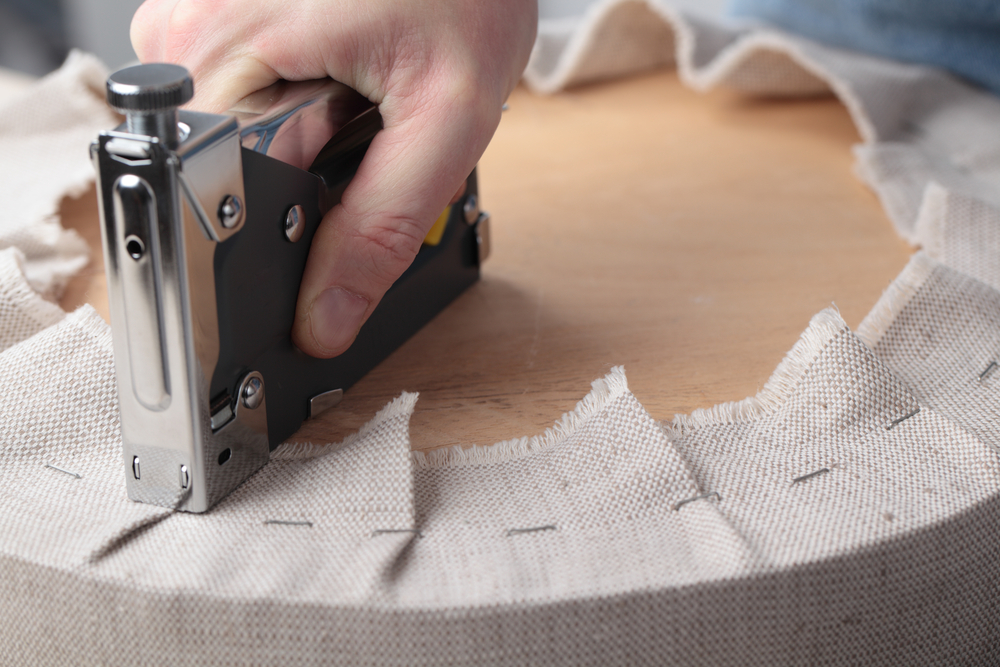
Stapler - best tool for fastening furniture covers
- When upholstering the former, carefully cut out the holes for the bolts with scissors and fill the edges of the cutouts with staples. If necessary, use a hammer to drive the staples into the wood more tightly.
- After stretching the upholstery, you need to cover the wrong sides with sheets of lining fabric. There is no need to waste time carefully cutting out the lining with scissors. Having outlined the approximate length, taking into account the folding of the edges 3-4 cm on each side, make a notch with scissors and tear the fabric; the synthetic lining breaks exactly along the thread, which you will not get when cutting with scissors. The inside of the lining should be shot from the corners, pulling the fabric tightly.
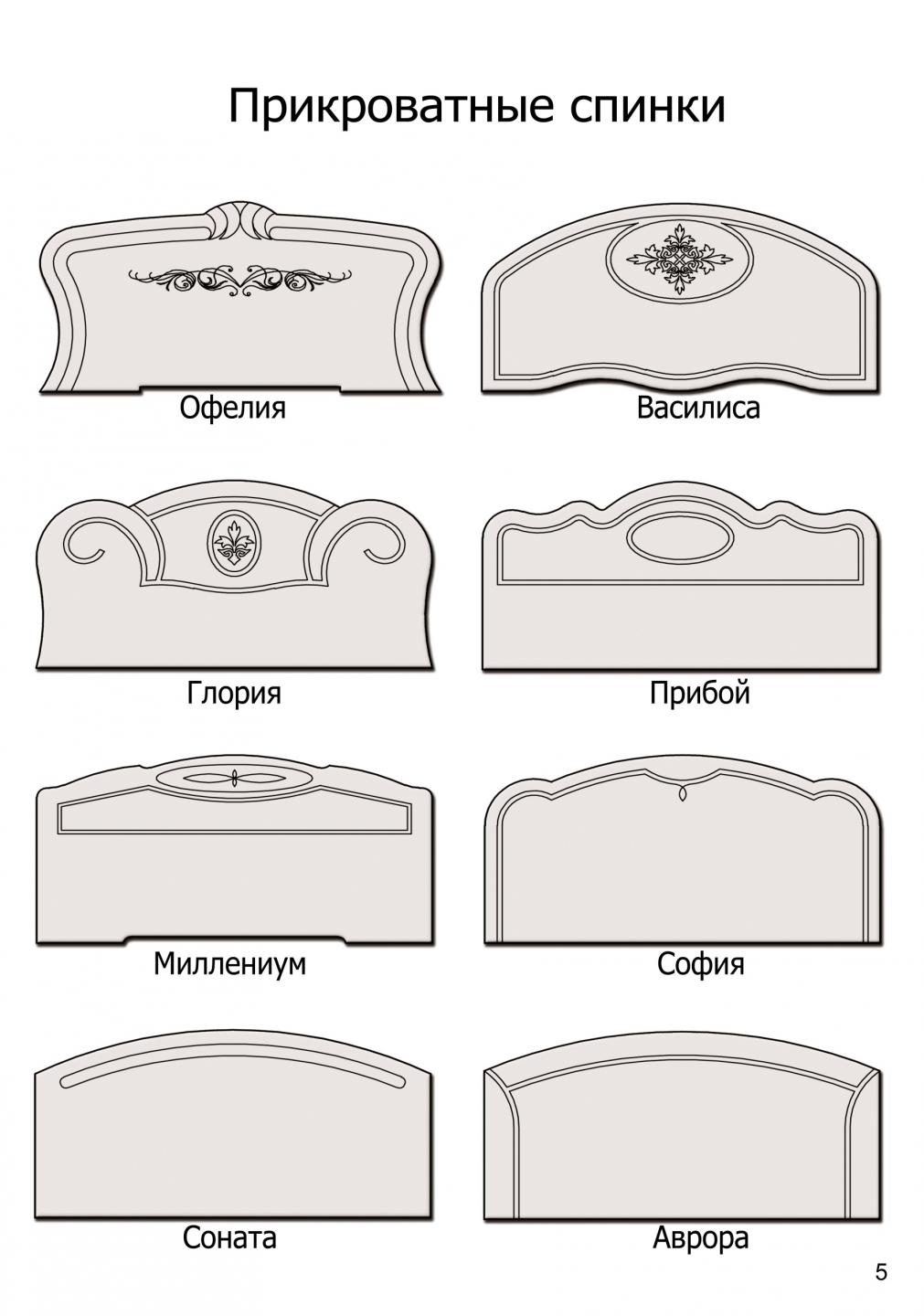
Byltse - (from Ukrainian) the back of a bed, chair, armrest of a sofa, armchair, etc.
The last stage of work is assembly. When assembling a sofa, first of all we attach the lock to the back and seat, then attach the resulting structure to the pallet of the sofa book and attach the bolts. When assembling a chair, you gradually install the seat and backrest to one frame, then attach the second to the structure. The legs are installed last.

Restoration helps transform old furniture into a new, stylish piece of furniture
Video: reupholstering an old chair
Since the process of reupholstering furniture is quite complex, we bring to your attention a short video that will clearly demonstrate all the stages of reupholstery, using the example of restoring an old chair.
Reupholstering upholstered furniture with your own hands is a responsible, labor-intensive task, but with excellent practical benefits and moral impact. You get satisfaction from the work done and the updated look of a piece of furniture you personally repaired. And most importantly - experience, which, who knows, can mark the beginning of a new hobby, and perhaps profitable business. Good luck with your renovation!
Date added: 2017-02-09
how to reupholster a sofa with your own hands
Let's give step by step instructions with photo.
Required Tools
In order to start reupholstering a sofa with your own hands, we need the following tool:
Flat head screwdriver
Pliers
Furniture stapler
Scissors
Kit wrenches. Usually 2-3 keys are enough. Sizes from 8 to 14.
Hammer
Sewing machine. If you don't have one, you can sew the pattern by hand or contact a clothing repair shop.
You may need an angle grinder (“grinder”) or powerful wire cutters to cut through the spring block ties. Because sometimes spring block may not match the dimensions of your sofa.
Main stages
Do-it-yourself sofa reupholstery and other upholstered furniture includes several main steps:
First of all, we need to disassemble our sofa. It is necessary to remove the components in the form of pillows, sides, poufs.
The sofa is dismantled using our tools. First, carefully disconnect the sides, remove all the overhead elements, the seat and the back. This is usually done quite simply, since manufacturers produce furniture with high maintainability. I advise you to put all the fasteners in some kind of box so as not to lose them. I also recommend taking photographs of the disassembly process. It will be easier to put everything back together later.
The next step is to remove the old upholstery that has become unusable. It can be removed using a regular flat-head screwdriver and pliers, since the staples hold the upholstery quite tightly. The work requires some care so as not to tear the old casing. We will use this fabric as a pattern for cutting out parts from the new fabric.
Then we clean all internal cavities from debris and dust. Old foam rubber should be mercilessly thrown away, since usually only dust remains from it. All metal meshes, various kinds of stretch marks, as well as springs must be carefully inspected and some detected defects must be eliminated. Ideally, the spring block should be replaced with a new one.
Nylon or fabric stretchers should be replaced with new ones. All screws must be carefully tightened, the joints of the parts must be strengthened, and the wooden joints must be glued.
Then we collect new insides. Let's consider this procedure using the example of one of the corner sofa pillows.
We will use furniture felt as a sealant. With help furniture stapler attach it to wooden base pillows.
Using a grinder or wire cutters, we prepare a spring block of the size we need
And install it on the base
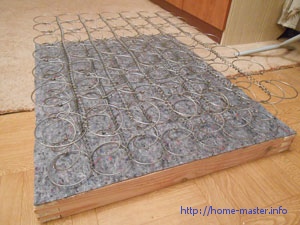
We secure the spring block using a stapler or steel staples
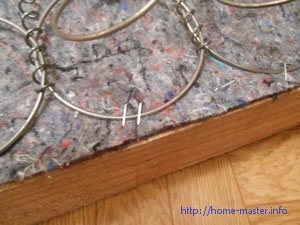
We cut out strips of 40 mm thick foam rubber according to the height of the springs. You can cut it with a sharp knife or using scissors.
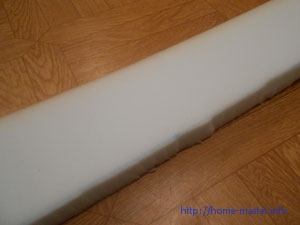
and lay them along the edge
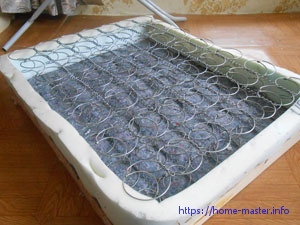
Putting together our “sandwich”
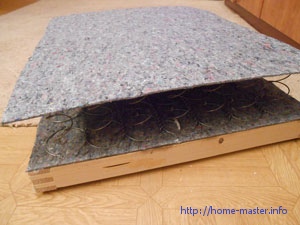
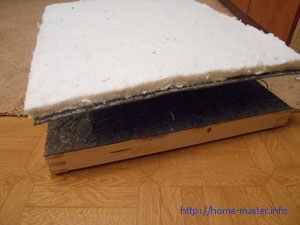
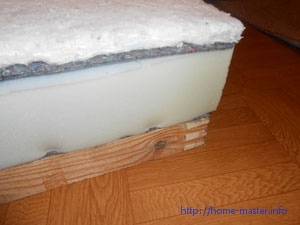
We glue the foam rubber using a special glue for foam rubber. We also glue upper layer felt and flooring. This is necessary to ensure that the flooring does not move during operation. As a last resort, this can be done using threads.
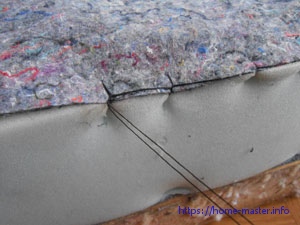
Our “sandwich” is ready. It's time to start cutting upholstery fabric. In order not to make a mistake with the amount of new fabric, it is recommended to buy it with a small margin. The remaining material can be used to cover kitchen stools or sew decorative pillows from it.
If the pillow was complex shape, then the old upholstery can serve as a template for the pattern, if you leave an allowance of a few centimeters along the edges of the new fabric.
Worn parts of the old upholstery are placed on new fabric and outlined with chalk or a piece of soap, then cut out with tailor's scissors.
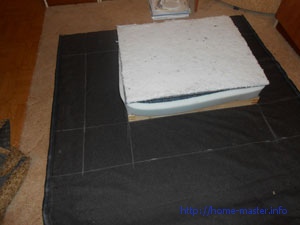
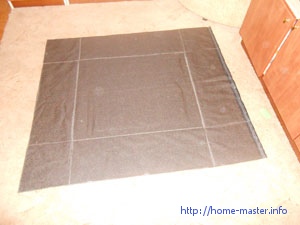
Then using sewing machine sewing our pattern
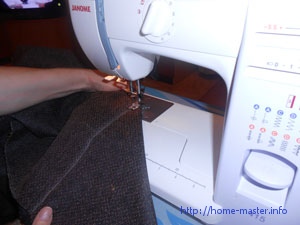
And we place our design there
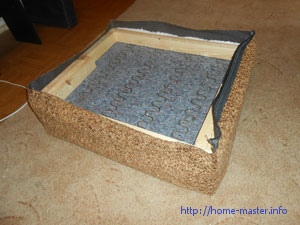
In order for the fabric to stretch evenly, you should start from the middle of the structure. We fasten on one side, then stretch and fasten on the opposite side. We repeat the operation on other faces.
As you work, stretch the fabric evenly and secure it with a stapler. The distance between staples should not exceed 4 cm.
At the end of the work, we close the lower part of the pillow with furniture non-woven fabric or lining fabric.
That's it - our pillow is ready. We repeat similar operations with other parts of our sofa. When everything is ready, we assemble our sofa.
I hope this article was useful to you. I will be glad to see your comments and constructive criticism.
It's no secret that the upholstery of upholstered furniture loses its original appearance very quickly. The mechanisms and fittings are often still in excellent condition, but the fabric is already very worn. The upholstery loses its former attractiveness, fades, becomes unusable and no longer fits into the interior of the room.
Such furniture is often thrown into a landfill or taken to the country. Sometimes specialists are invited to reupholster and give the furniture a new look. For the home handyman good to know, how to reupholster a sofa with your own hands. This skill does not require the knowledge of an experienced furniture maker, you only need desire and accuracy.
Home electrician. Tools and accessories
A modern apartment is full of quite complex equipment powered by electrical network. Therefore, the range of work of a home craftsman related to electricity is quite wide. Sometimes these works are not related to electricity, but their implementation is necessary and requires certain knowledge. With this article we will begin a series of articles devoted to working with electricity.
Whatever electrical work is done in the house, it must be done under conditions of absolute safety. In this regard, it is important to make sure that there is no voltage in the wire. This can be done using an indicator screwdriver. This article will talk about correct use this most important tool.
The repairs are done, the walls are leveled using plasterboard - it’s nice to look at... But then the need arises to hang a shelf or a picture on the wall... And the question begins to torment you: with what to do this?
After all, drywall is not concrete or Brick wall, where you can hang anything with a drill and dowel.
But don't despair! There is a solution to this problem too.
Each of us is a PC user, and sooner or later, we may find ourselves in a situation where we need to replace a device in our computer or purchase a new PC.




